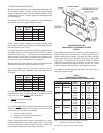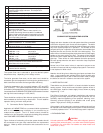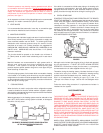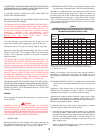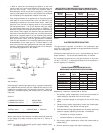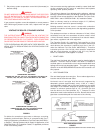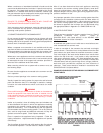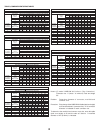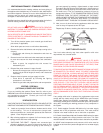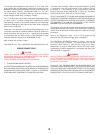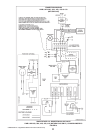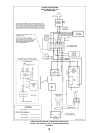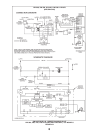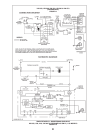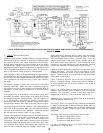
1515
1515
15
VENTING MAINTENANCE - STANDARD VENTING
It is recommended that the heating surfaces and vent piping of
the appliance be checked every six months for dust, deterioration
and carbon deposits. Remove all soot or other obstructions from
chimney and flue which will retard free draft. Replace any
damaged or deteriorated parts of the venting system.
Qualified servicers should follow this procedure when the boiler’s
external heating surfaces and vent pipe need cleaning.
CAUTION
DO NOT USE A NYLON BRUSH OR OTHER STATIC CREATING
MATERIAL TO CLEAN DUST AND CARBON DEPOSITS FROM
HEATING SURFACES AND VENT.
SUCH DEPOSITS ARE FLAMMABLE AND MAY BE IGNITED BY
STATIC ELECTRICITY. USE A METAL BRUSH TO MINIMIZE THE
DANGER OF EXPLOSION.
1. Turn off the electrical power (main manual gas shutoff and
pilot valves, if applicable).
Allow boiler parts and vent to cool before disassembly.
2. Remove the boiler draft diverter and vent pipe running to the
chimney.
• Check parts and chimney for obstructions and clean as
necessary.
3. Remove burner from boiler and other metal parts as required
to clean and vacuum the heat exchanger and combustion
coils.
• Refer to parts list supplied with this manual for
disassembly aid.
4. Reinstall the parts removed in steps 2 and 3.
• Be sure the vent pipe has a minimum upward pitch of one
quarter inch per foot of length (21mm/m) and is sealed as
necessary.
5. Restore electrical power and gas supply to boiler.
• Place boiler in operation by following the lighting
instructions in this manual.
• Check for gas leaks and proper boiler and vent operation.
VENTING - SIDEWALL
(OPTIONAL) POWER VENT SYSTEM
If you are installing the optional Power Vent Kit, refer to your
HWB/HW Power Vent Kit Installation Instructions for proper wiring
and installation procedures. Contact your local A.O. Smith
representative for details.
VENTING SYSTEM
HAVE VENTING SYSTEM CHECKED EVERY SIX MONTHS FOR
OBSTRUCTIONS AND/OR DETERIORATION IN VENT PIPING.
A. Insofar as is practical, close all doors, windows and air inlets
to the building. Turn on all exhaust fans (range hood,
bathroom exhaust, etc.) so they will operate at their maximum
speed. Close fireplace dampers.
B. After allowing appliance to operate for five minutes, test for
spillage at the draft hood relief opening.
C. “CHECKING THE DRAFT. Operate vent connected gas
utilization equipment for several minutes and check to see
that the combustion products are going up the chimney or
gas vent properly by passing a lighted match or taper around
the edge of the relief opening of the draft hood. If the chimney or
gas vent is drawing properly, the match flame will be drawn into
the draft hood. If not, the combustion products will tend to
extinguish this flame. IF THE COMBUSTION PRODUCTS ARE
ESCAPING FROM THE RELIEF OPENING OF THE DRAFT
HOOD, DO NOT OPERATE THE EQUIPMENT UNTIL PROPER
ADJUSTMENT OR REPAIRS ARE MADE TO PROVIDE
ADEQUATE DRAFT THROUGH THE CHIMNEY OR GAS VENT.”
D. Next, turn on all other fuel burning appliances within the same
room so they will operate at their full input.
Repeat step C above, checking the draft on each appliance.
FIGURE 9
SAFETY RELIEF VALVES
Your local code authority may have other specific relief valve
requirements not covered below.
WARNING
THE PURPOSE OF A SAFETY RELIEF VALVE IS TO AVOID
EXCESSIVE PRESSURE OR TEMPERATURE INTO THE STEAM
RANGE WHICH MAY CAUSE SCALDING AT FIXTURES, TANK
EXPLOSION, SYSTEM OR BOILER DAMAGE.
TO AVOID SCALDING OR WATER DAMAGE A DRAIN LINE MUST
BE CONNECTED TO A RELIEF VALVE TO DIRECT DISCHARGE
TO A SAFE LOCATION. A DRAIN LINE MUST NOT BE REDUCED
FROM THE SIZE OF THE VALVE OUTLET AND IT MUST NOT
CONTAIN ANY VALVES BETWEEN THE BOILER AND THE RELIEF
VALVE OR THE RELIEF VALVE AND THE DRAIN EXIT. IN ADDITION,
THERE SHOULD NOT BE ANY RESTRICTIONS IN A DRAIN LINE
NOR SHOULD IT BE ROUTED THROUGH AREAS WHERE
FREEZING CONDITIONS MIGHT OCCUR. DO NOT THREAD OR
CAP THE DRAIN LINE EXIT. RESTRICTING OR BLOCKING A DRAIN
LINE WILL DEFEAT THE PURPOSE OF THE RELIEF VALVE AND
MAY CREATE AN UNSAFE CONDITION. INSTALL A DRAIN LINE
WITH A DOWNWARD SLOPE SUCH THAT IT NATURALLY DRAINS
ITSELF.
If any safety relief valve is replaced, the replacement valve must
comply with the latest version of the ASME Boiler and Pressure
Vessel Code, Section IV or CSA B51, as applicable. Select a relief
valve with a discharge NOT less than the boiler input, and a pressure
rating NOT exceeding the working pressure of any component in
the system.
A. O. Smith supplies Canadian HW boilers for hot water supply
systems with a 125 psi pressure relief valve. This valve must be
installed in the water outlet as near to the boiler as possible.
A. O. Smith United States HW and Canadian HWB boilers for space
heating are shipped with a 50 psi pressure relief valve. This valve
must be installed in the water outlet as near to the boiler as possible.
An ASME rated temperature and pressure relief valve must be
installed on each and every water storage tank in a hot water supply
system.



